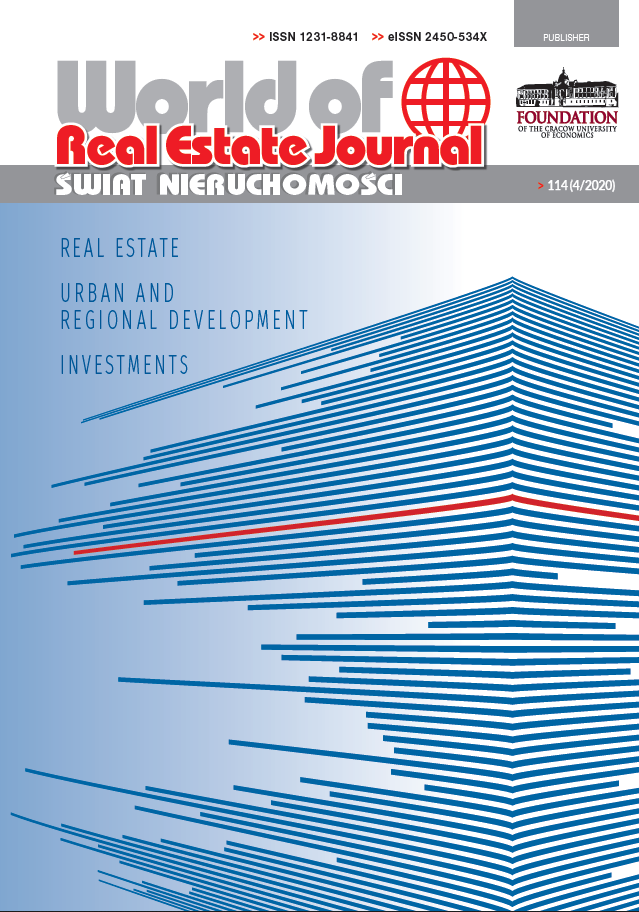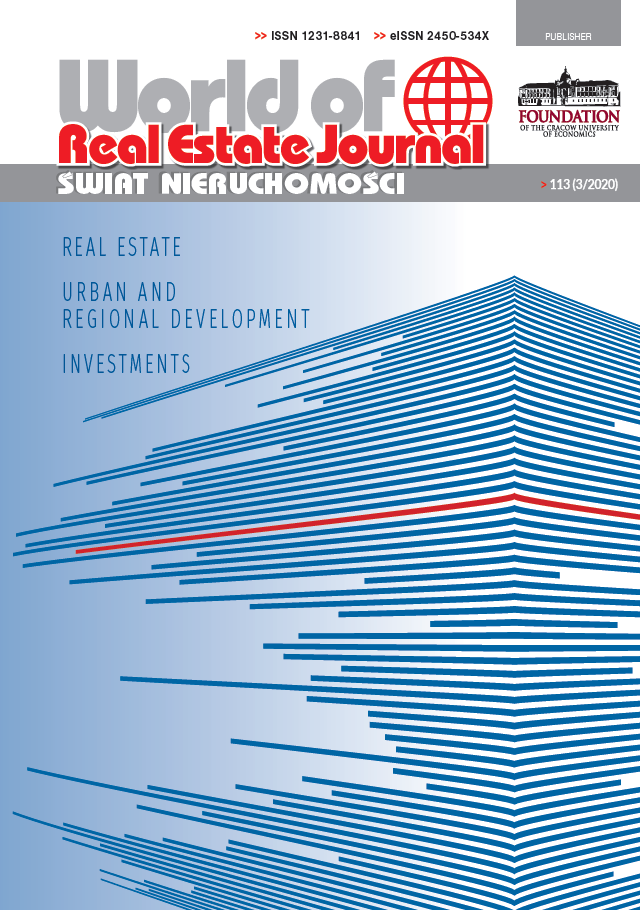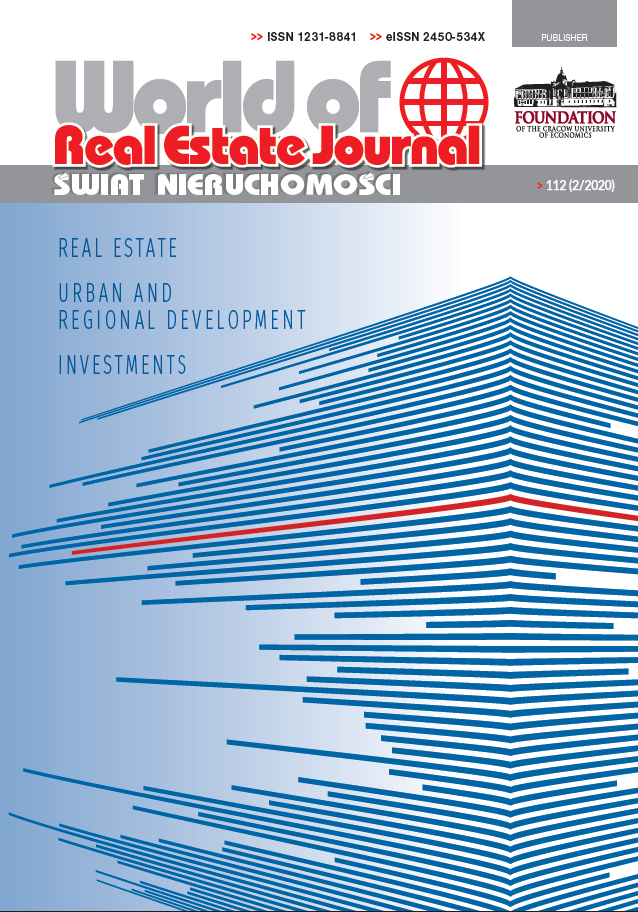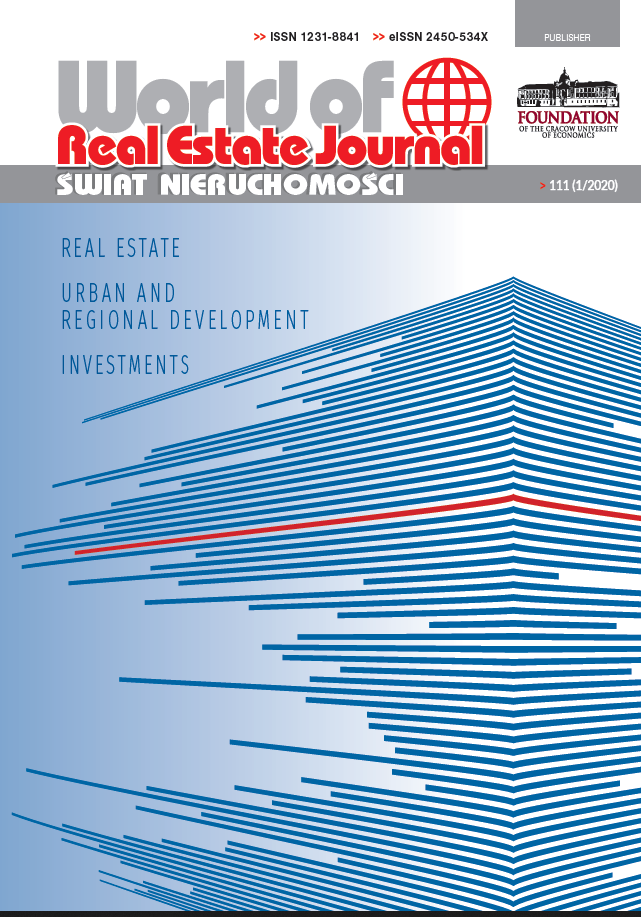MARKET
1) Krzysztof Nowak - The Elasticity of the Office Space Market in Poland: Looking for the London Effect
2) Anna Jancz - Seniors’ Housing Preferences in the Rural Areas
PROBLEMS OF URBAN AND REGIONAL DEVELOPMENT
3) Paweł Dziekański, Urszula Karpińska- Synthetic Assessment of the Impact of Housing Management Variables on the Level of Development of Communes in the Świętokrzyskie Voivodship in the Years 2009-2017
4) Milena Bera, Monika Śpiewak - Analysis of municipal real estate resources in Poland
HOUSING
5) Ewa Kucharska-Stasiak, Magdalena Załęczna, Konrad Żelazowski - The evolution of housing policy models in European countries. Theoretical approach
CONFERENCES
6) Katarzyna Kania - Jubilee Conference of the Department of Investment and Real Estate of the Poznan University of Economics entitled “Real Estate Market Border” (Poznań, 9-10 May 2019). DOWNLOAD
SUMMARIES
Krzysztof Nowak - The Elasticity of the Office Space Market in Poland: Looking for the London Effect
Purpose: The article concerns the elasticities of demand in the office space market. The article presents indicated in the literature reasons for discrepancies in magnitude of elasticities of demand on local office space markets. The purpose of the article is to verify the presence o the so called London effect on polish office space market.
Method: The verification of the hypotheses stated in the study was carried out by comparison of the calculated price and income elasticities of demand on the office space markets in Warsaw, Krakow, Wroclaw and Poznan. For the purpose of the study two econometric models were formulated with a use of the Error Correction Model approach.
Findings: The London effect was verified on the four major office space markets in Poland. To this end, two research hypotheses were formulated stating that price elasticity of demand and income elasticity of demand on the office space market in Warsaw is lower in magnitude than on the markets in Krakow, Wroclaw and Poznan together. Based on the study, the presence of the London effect on the four major office markets in Poland cannot be unambiguously confirmed. Office space markets in Krakow, Wroclaw and Poznan are on the earlier stage of development than in Warsaw. This affects the availability of reliable data and causes the fact that in case of Model 1 for first three cities the time range of data used in the study is shorter than in Model 2. Furthermore, time series that have been used to determine demand variables in both models are not exact.
Research implications: Dependencies between rent and number of employees and the need for office space are different in Warsaw than on the office space markets in Krakow, Wroclaw and Poznan.
Keywords: price elasticity of demand, income elasticity of demand, office market, error correction model
JEL codes: R30, R33
Category of the paper: research article
CITATION (APA): Nowak, K. (2019). The Elasticity of the Office Space Market in Poland: Looking for the London Effect. World of Real Estate Journal, 108(2), 5-18.
DOI: https://doi.org/10.14659/worej.2019.108.01
READ ALL...
Anna Jancz - Seniors’ Housing Preferences in the Rural Areas
Purpose: Identify senior people’s housing preferences
Methods: Survey questionnaire conducted among seniors in rural communes of the Greater Poland Province
Findings: What was characteristic of the group under the survey was their accommodation in a single-family house. The respondents were not inclined to migrate and they preferred to stay in their present house or flat and adapt it to suit their future needs connected with the old age.
People who would decide to move would mostly choose to live a detached/terraced house (up to 100m2) or a two-room flat in a low block (up to four floors). As regards financing, they would prefer to exchange their old flat for a new one or sign a long-term rent agreement. The respondents would like to live in the countryside or in the outskirts of the city. They would also choose a location not too distant from their present place of living due to their family relations and neighbour friends.
The respondents would also consider moving to a building adapted to the needs of senior residents – flats with facilities for disabled people and services available for seniors. The most valued services were medical-nursing and rehabilitation care. Housing preferences of older people living in a rural area were difficult to determine, especially among men. During meetings of seniors most often women participated. Research was time consuming and expensive. The housing preferences survey for seniors should be extended to studies in other voivodships.
Research implications: The research can be used by local government and developers to create an offer of senior housing in Poland for different groups of elderly people.
Keywords: housing needs; housing preferences; senior; housing market
JEL codes: R31
Category of the paper: research article
CITATION (APA): Jancz, A. (2019). Seniors’ Housing Preferences in the Rural Area. World of Real Estate Journal, 108(2), 19-35.
DOI: https://doi.org/10.14659/worej.2019.108.02
READ ALL...
Paweł Dziekański, Urszula Karpińska - Synthetic Assessment of the Impact of Housing Management Variables on the Level of Development of Communes in the Świętokrzyskie Voivodship in the Years 2009-2017
Purpose: Municipalities operate in a dynamic environment of individual internal and external resources. They form a network of interrelationships, occur at the same time and are interdependent. The development of communes is shaped by many different elements making up the demographic, economic, financial and environmental aspects, connected by the multidimensional space of the facility. The aim of the article is to assess the level of development of communes in a multidimensional context in the aspec variables of housing management and to determine its spatial diversity using a synthetic measure.
Mathods: As the source material, data from the Local Data Base of the Central Statistical Office from 2009-2017 were used. The analyzes were carried out in the system of 102 communes of the Świętokrzyskie Province. The following had the greatest impact on the level of development of the Świętokrzyskie Voivodeship communes: own income, the level of unemployment, the number of employed persons, economic entities, natural persons conducting economic activity, flats with water supply, bathroom and central heating.
Findings: In 2009, the TOPSIS synthetic measure of development ranged from 0.34 to 0.57 and in 2017 from 0.32 to 0.62. The synthetic measure of development Si in 2009 ranged from 0.26 to 0.61, and in 2017 from 0.24 to 0.67. Regardless of the method of determining the synthetic measure, the best units were Kielce, Sandomierz, Ostrowiec Św., Sitkówka-Nowiny. They are characterized by a developed industrial and tourist function and the highest level of expenditure on housing and the number of flats per 1000 inhabitants. The weakest units were Bliżyn, Fałków, Gowarczów, Mirzec, Imielno, and Waśniów. They were characterized by a developed agricultural function. The main limitation of the study was the unavailability of variables at the level of municipalities, which affected the number of elements of the synthetic measure structure.
Research implications: The results obtained are an assessment of the housing policy implemented by local authorities. They can also serve councilors, students, local economy entities and institutions interested in local development.
Keywords: synthetic measure, development of communes, determinants of development, housing economy
JEL codes: R13, R58
Category of the paper: research article
CITATION (APA): Dziekański, P., & Karpińska, U. (2019). Synthetic Assessment of the Impact of Housing Management Variables on the Level of Development of Communes in the Świętokrzyskie Voivodship in the Years 2009-2017. World of Real Estate Journal, 108(2), 36-55.
DOI: https://doi.org/10.14659/worej.2019.108.03
READ ALL...
Milena Bera, Monika Śpiewak - Analysis of Municipal Real Estate Resources in Poland
Purpose: The objective of the article was to analyse municipal real estate resources in Poland. The objective was achieved through the classification of 16 provinces in Poland in terms of the state of the municipal real estate economy in Poland. The evaluation encompassed municipal real estate resources, taking into account their access to infrastructure
Method: The empirical part of the research was described with the use of data originating from the publication of the Chief Statistical Office. The research referred to the year of 2016. Heuristic methods, such as „brain storming” and the Delphi method were used for the measurement and evaluation of the phenomenon. In order to rank the provinces on account of their municipal real estate resources, a taxonomic development measure was calculated.
Findings: The status of municipal real estate resources largely depends on the size of municipal real estate resources and the manner of their management by local authorities. It needs to be emphasised that in many provinces both municipal. district and province authorities try to limit municipal real estate resources because their maintenance generates costs. Hence frequently local government authorities. Using the right of pre-emption sell the real estate to tenants. There is no statistical data for the x4 variable
Research implications: The research should be continued in the following years, which will allow comparative analysis.
Keywords: municipal real estate, province, Poland, real estate
JEL codes: R38
Category of the paper: research article
CITATION (APA): Bera, M., & Śpiewak, M. (2019). Analysis of Municipal Real Estate Resources in Poland. World of Real Estate Journal, 108(2), 56-68.
DOI: https://doi.org/10.14659/worej.2019.108.04
READ ALL...
Ewa Kucharska-Stasiak, Magdalena Załęczna, Konrad Żelazowski - The Evolution of Housing Policy Models in European Countries. Theoretical Approach
Purpose: Housing policy is a component of social policy; it attempts to study and assess the housing problems and ways of equalizing opportunities in access to housing services. The article aims to present the development of housing policy models in Europe to indicate the directions of their changes, and to assess the effects of their implementation.
Methods: A systematic review of the literature and comparative analysis were used to distinguish the most popular housing policy classifications as well as to systematize knowledge on the drivers of the evolution of housing models.
Findings: The study indicates a multitude of classifications of housing policy models. They all have roots in Donnison's original work but differ in nomenclature and complexity resulting from valorization rules. They reveal the importance of historical, social, cultural, and political conditions in the evolution of housing policy. For achieving the objectives of housing policy, the comprehensive model, in which the state participates in the process of satisfying housing needs, was proved to be more productive. The article is theoretical and does not verify the effectiveness of the presented housing policy models to a greater extent.
Research implications: The article highlights the fundamental differences between the main models of housing policy and the mechanism of their evolution. Besides, it presents a critical stance on the concept of housing policy of post-socialist countries, which, due to strongly market-oriented solutions focused mainly on private ownership of housing, did not significantly improve their housing situation.
Keywords: housing policy, housing policy models, socio-economic inequalities
JEL codes: O18, R31
Category of the paper: review article
CITATION (APA): Kucharska-Stasiak,E., Załęczna, M. & Żelazowski, K. (2019). The Evolution of Housing Policy Models in European Countries. Theoretical Approach. World of Real Estate Journal, 108(2), 69-85.
DOI: https://doi.org/10.14659/worej.2019.108.05
READ ALL...
























































